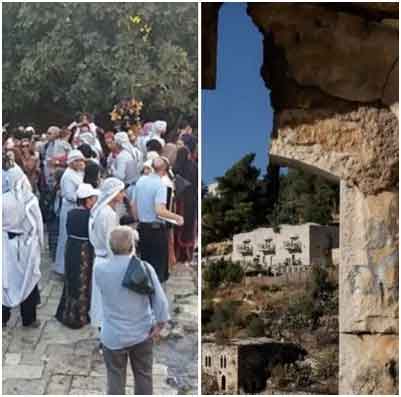
Image: Left: Palestinians rallying in Lifta, northwest of Jerusalem (Apr 21, 2017). Right: from The Guardian article titled “‘We will return’: the battle to save an ancient Palestinian village from demolition”
Much as I welcome the proliferation of articles on saving the ruins of Lifta from the Israeli development industry, I would much rather read articles that focus on saving these ruins for the purpose of reconstruction by their rightful owners, many of whom are just waiting for such an opportunity, armed with deeds and architectural plans, only a stone’s throw away.
The articles one reads now advocating against Israel’s plans to hand over the site to developers seem to stress the idea that saving the ruins of Lifta from demolition will serve to enrich Israel’s cultural and historical “heritage.” Lifta was added to the 2018 World Monuments Watch list of endangered heritage sites.
Lifta for Palestinians, according to this vision, is now a monument, a symbol of the Nakba to feel nostalgic about. At best, it is useful in educating Israeli Jews and the world at large about Israel’s, not Palestine’s, history. After all, doesn’t Facebook locate where I am from as “From Lifta, Yerushalayim, Israel”?

Image: Israeli Jews in Lifta hold a middle finger to a group of Palestinian children visiting the site. [Blekh | MintPress News]
Even Palestinians being interviewed for these articles do not veer in their narration from a vision of loss seemingly impossible to redeem: “Lifta is a witness of what happened during the Nakba,” says a Palestinian in an article titled “The Fight to Save Lifta, the Last Remaining Palestinian Village.” Another explains:
In December 1947, the Haganah killed a Palestinian business owner in Lifta. Later that month, one of Lifta’s two coffeehouses was ambushed with gunfire and grenades. The attack killed six and wounded seven. Two months into 1948, the Jewish Agency chairman and future first prime minister of Israel, David Ben-Gurion, boasted of the ethnic cleansing’s success, telling his political party members: “From your entry into Jerusalem through Lifta — Romema, through Mahane Yehuda, King George Street and Mea She’arim — there are no strangers. One hundred percent Jews.
But a recent article in The Guardian on saving Lifta from Israel’s land authority’s plans to “redevelop” the “abandoned” Palestinian village ends with a sentence that finally strikes the right note:
“… many of Lifta’s houses have a small Palestinian flag painted inside their doorframes and a single statement, or wish, inscribed below in Arabic: ‘We will return.’”
Within this article several images are displayed (the usual artistic views of Lifta’s ruins in various seasons and lighting conditions). None show pictures of the Palestinian families of Lifta who live just a few kilometers away in Jerusalem rallying on the grounds of Lifta for their return.
The reader of these articles doesn’t learn about Dr. Salman Abu Sitta’s reconstruction project and the practicality of his plans for return. Perhaps that’s because so many still disbelieve, like the Israeli writer Amos Oz, that Palestinians can or should go back in both “time” and “space.” Oz called Palestinian longing for return an “illness” of “reconstritis,” shouting at a Palestinian exile from Lifta at a lecture just before Oz died:
If you miss Lifta so much, write a book. Make a film. Write a play. Write up a research. Seek what you have lost in time, not in space… You miss your childhood? That’s OK, but if you start behaving like a 5-year old child [Oz is literally shouting here] because of your childhood longings, you need to be hospitalized!
Well, one such “ill” Palestinian, Dr. Salman Abu Sitta has, in fact, written a book (Mapping My Return: A Palestinian Memoir), but he has also dug up every piece of information and documented the location of hundreds of Palestinian homes and villages before Zionist Jewish forces wiped their existence off the map. What’s more, he is able to demonstrate, with irrefutable facts and figures, that Palestinian return is far from an “ill” fantasy. It is not only possible, but necessary:
In “The feasibility of the right of return,” Abu Sitta writes:
The argument which gains currency, especially among people who believe that the Right of Return is legal and just, is the assumption that Israel is fully populated and that any returnees would displace existing Jewish residents. It will be shown that this fear is unfounded and that the return of the refugees is possible with no appreciable dislocation to the Jewish residents.
… But even in the most congested case, only 154,000 Jews may choose to relocate elsewhere in Israel to allow 4,476,000 refugees to return to their homes and end half a century of destitution and suffering. This is a very cheap price Israel should pay for what it has inflicted upon the Palestinians and still cheaper price to pay for a secure future for both peoples.
Abu Sitta’s huge database is being used as the source of inspiration for students of architecture who are rebuilding Palestinian history — reconstructing that which Zionist aggression has destroyed. To see one such reconstruction of Lifta, watch this:
It is this powerful, paradigm-shifting vision I wish upcoming articles on Lifta would develop, because it promises the feasibility of our return.
Rima Najjar is a Palestinian whose father’s side of the family comes from the forcibly depopulated village of Lifta on the western outskirts of Jerusalem and whose mother’s side of the family is from Ijzim, south of Haifa. She is an activist, researcher and retired professor of English literature, Al-Quds University, occupied West Bank.







































